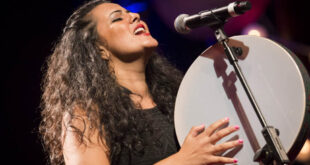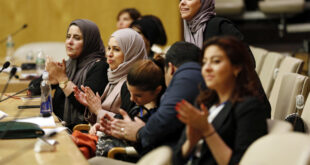Cambridge Arab Media Project: The Media and Political Change in the Arab World, 29-30 September 2004
"Empowerment" is a term that appeared for the first time in the UN's World Survey on the Role of Women in Development (1986). It referred to the productivity of agriculture, and was defined as a process that "entails much more than awareness of alternatives, women's rights and the nature of requirements. It involves the breakdown of powerful sex stereotyping, which prevents women from demanding their rights from positions of authority." In 1995, Empowerment became part of the mainstream terminology of the Beijing document where the process of empowering women entailed 'reforming' the media, i.e., carving space for women in the media. The document also demanded assigning women the power of decision-making in the media industry. Both demands, however, were novel to the cultural scene in the Arab world. On the governmental and non-governmental levels, huge efforts were carried out, during the last decade, to increase the number of women involved in the media industry. All new feminist voices were struggling to be heard as a corrective of the negative images of women widespread in the media. Those voices took issue with the construction of the real by the media, and therefore, patriarchal authority was highly challenged.
In 2004, the struggle for incorporating women in the media has become old-fashioned, since women are already everywhere on Arab satellites and the state-controlled media. Yet, the question is to be posed again, how do media images construct and constrain, empower and disempower, feminist objectives in particular and women's position in general? In this paper, I claim that satellites in their modern form are catering for globalization. Does that make sense? Can we really blame globalization for any negativity? And which part of globalization, capitalist profits, mass culture, or the resistance has it naturally generated? Probably all of those.
These are the times of huge masses, where the media has to target the masses by turning culture into mass culture. The criterion of success, then, is the increase of viewership. Such an increase means mere quantity profit increase. In the era of the masses, as Galal Amin states, the competition depends on satisfying and catering for all tastes, not only the middle class as it used to be in the 60's (1). Women are, unfortunately, an essential part of this competition. To discuss feminist issues on any satellite is seen to be too academic, too serious, and too dull. No spectacular fun. However, it should be noted that satellites derive their disposition from society itself. In reality, feminist issues do not pass easily. The most problematic issue until now is how to raise the social awareness in relation to feminism, how to incorporate gender not only in the media, but also in the work place, in education, in politics, and in the process of decision making. So satellites have moved the battle from reality to the screen, i.e., crude reality is displayed and exaggerated through generic and cultural verisimilitude.
In the era of masses, women are caught between two extremities, capitalist patriarchy and patriarchal fundamentalism. Paradoxically, or rather ironically, both ideologies take the body as their cult. The battle ground is the female body, whether to display it or to hide it. In Shakespearian terms: to be or not to be, that is the question. This in itself is an oversimplification similar to the US discourse that followed the invasion of Afghanistan when the women were shown as victimized by Taliban and rescued by the American ex machina, just by changing the dress code. There is more to it.
I. The discourse of displaying the body
According to Foucault, discourses are the bearers of various historically specific positions of agency and identity for individuals/spectators. It is these subject-positions that provide the conditions for individuals to act or know in relation to particular social practices. This conception of subject positions was used by Sean Nixon to read the 'new man'; it could as well be used to read the 'new woman' (2). This will be done through examining the exhibition of femininity as presented by video clips, the dress code, the measures of the body, and even the language. Nancy Agram, Elissa, Haifa' Wahbi, and others are Lebanese women singers whose appearance has caused radical changes in relation to women's self-image and social image. They stand for the cult of femininity where the body takes hold of the consciousness. Put differently, all efforts to empower women's consciousness have collapsed by reason of the intensification of the pleasures of the body, its posture and movements and the solidifying of certain practices. One of the results is the conspicuous increase in plastic surgery undertaken by women to reach that level of 'femininity'. The other thing is that Lebanon, where these singers come from, has come to stand for the place of 'femininity' and sensual pleasures. Nobody credits or remembers the role of Lebanese women in resistance anymore. It must be noted here that there are around twenty channels or so that broadcast only video clips all day long. They managed to glue all young men and women in front of the screen by employing all available means of technology. The most famous thing is the SMS's that run constantly on the screen carrying messages from boys to girls and vice versa. In Cairo, cafes compete to provide the biggest screens in order to attract more people. This has become a phenomenon even in traditional authentic cafes.
In reality women are expected to imitate the appearance of those images without being won over in the head. That is to say, they are expected to be as sexy as those women, yet, as modest as Virgin Mary. Such an expectation dismembers women's consciousness strongly and subtly, and thus, any claim to a feminist stand sounds ludicrous. To say that this discourse disempowers women is another distortion of the process of assimilation. Those images of femininity have led to catastrophic results. The press has become so preoccupied with attacking those images, constantly confusing images on the screen and women in reality. The images of video clips are taken to be the representation of women, a fact that proves the role of the popular media in constructing the real.
The attack derives its legitimacy from the high tone of morality of the middle class. Consequently, all women's issues are on hold in the press till this moral crisis is resolved. Reality television, a recent phenomenon on Arab satellites, has intensified this crisis. A special channel, named Sawa, was launched just to display women in the market of marriage. The success of that program encouraged other satellites to imitate it, this time under the cover of art, like the Star Academy program of LBC. In Bahrain, another reality program, an imitation of the American program Big Brother, was cancelled as a result of the severe social criticism it received.
There are two essential remarks that I want to make here. The first is about the owners of those satellites. The grandson of Gamal Abdel Nasser, the famous Egyptian national hero who gave Egyptian women their suffrage rights, owns 'Melody,' for example, which runs video clips all day long. Rotana, the most popular satellite network in the Arab world, is owned by Al Waleed bin Talal, a Saudi Emir whose father established the famous Arab Council of Motherhood and Childhood. The list could go on: Saudi businessmen also own MBC and ART. ART has a channel that broadcasts videoclips and at the same time has another that hosts Amr Khaled who magically convinced millions of young women to take the veil. The second remark is related to the damage these videoclips cause by the distorted vision it propagates, if there is a vision at all. To see women displayed as sexual objects on these channels is already understood, but to witness how women could be used in the political context of banning the veil in the schools of France is really frightening. A Kuwaiti singer produced a song about that issue where an extremely beautiful woman is expelled from her job because she is veiled. So we see the woman unveiled sexily and then we see her veiled on the street like an innocent angel. This is the easiest way, I guess, to turn real issues into superficial ones and to antagonize the other. Apparently, images of women as victims appeal to the patriarchal mentality. This is a universal fact as we always hear in the news of war--any war--the number of injured women and children. Hence, condemnation. I have to mention here the funny thing I noticed lately in commercials of soap, milk, softeners, etc., where there two versions--on one satellite the woman is veiled, on the other unveiled.
This exaggerated display of and obsession with the female body has generated the extreme opposite, namely, the exaggerated fundamentalist discourse of other satellites. That came as a natural result, since any power yields its own resistance. That fundamentalist discourse is not without its legitimacy as well. Basically, it attacks those images from within an Islamic religious framework; yet, it has many allies who do not adopt an Islamic framework of thinking. This fundamental attack meets with all other attackers in the point of challenging the conception of women as commodity. In other words, the Islamic discourse vis-à-vis those images derives its credibility from the anger of the Arab viewer who is already crammed with so many images of oppression and injustice where sexuality cannot be accommodated by any means. Even the principle of the popular aesthetic advanced by Bordieu cannot be a tool of analysis here. It is a luxury that Arab men and women cannot afford right now.
II. The discourse of denying agency
Hiding the female body, denying any free female agency, and elevating the political are the areas propagated by other satellites. Those satellites depend on debates, talk shows, and the news. Al Jazeera's fame increased recently due to the American attack on it, such attacks being even the criteria which led the politician M.H. Heikal to speak on it. Al Arabiya is trying to compete by adopting a more balanced discourse; this did not help the channel to gain the same huge popularity as that of Al Jazeera. Let's look at Al Jazeera, however, as a case study since it enjoys high viewership in the Arab world. Al Jazeera cannot be described as fanatic or Islamic or fundamental. So, what is it? To understand that channel one should look at the main subjects being discussed which could fall under two broad categories of politics and sexuality.
For Women Only (Lil Nisa' Faqat) is a famous weekly program that usually hosts three guests and also receives phone calls from viewers. It usually takes the form of a debate--a heated one sometimes--where binary oppositions are consolidated; for example, women's position in Islam as opposed to women's position in human rights charters, veiled women as opposed to unveiled women, Islamic women activists as opposed to feminist activists, feminist creativity as opposed to universal human creativity, Islam as opposed to gender, commercial and popular media as opposed to committed media, and so on. Banning the veil in France was also an issue. Such binary oppositions formulated in the form of either/or formulas not only exclude any other epistemology but also block the way socially for any feminist voice.
Also on Al Jazeera, women's suffering is shown with a relentless focus on individual incidents (Palestinian and Iraqi women) and a total marginalization of the overall context of patriarchy, male domination, systems of racialized inequality, and above all, capitalism. That shows clearly in the program Al Sharia wal-Hayat (Sharia and Life), where the tone of Sheikh Al-Qaradawi is highly patronizing towards women, lenient towards men, and accusative of the West. In one episode, referring ironically to the Moroccan plan of incorporating women in development, he stated, "We are not the ones who discriminated against women, it's God who did that. Women are different from men in body and mind. This does not mean that there is equality. There is indeed, but only in some areas. Men and women are not enemies, they complement each other. Anyway, they are equal in reward and punishment" (Dec. 7, 2000). Obviously, the discourse is extremely masculine and patriarchal; it does not take issue with reality or power relations. In another episode, where the topic was 'liberating women in the Arab world,' Al-Qaradawi accused all women's NGO's of being westernized and of propagating American globalization (Dec. 8, 2000).
As I see it, any attempt at establishing a free female agency in the programs of Al Jazeera is aborted by a severe high-pitched discourse of patriarchal fundamentalism. Women are elevated and acknowledged only when they participate in the national struggle. To explain, the political completely marginalizes the social and excludes any other factor. Women's position in the public sphere is discussed at length in relation to development, politics, and education, whereas the problems of the private sphere are rarely talked about . "In a society such as our own we all know the rules of exclusion," says Foucault. He continues, "In appearance, speech may well be of little account, but the prohibitions surrounding it soon reveal its links with desire and power... Speech is no more verbalization of conflicts and systems of domination ... it is the very object of man's conflicts" (3). The conflict lies also in who controls, selects, and organizes the information and the construction of images, who claims authority and who wants to cast doubt on the other different voice.
My other concern is to look at the discourse of some initiatives of reform where the media industry is an essential component. However, in those initiatives critiquing the media is never linked to reforming women's status. For example, in the initiative of the Muslim Brothers there is a direct demand to reform the media according to "the principles of Islam." In the initiative of Egypt's left-wing Tagammu' Party, reform of the media is mentioned in relation to achieving freedom of expression. In the Alexandria Document, freeing the media from the hegemony of the government is an explicit political demand. Only in the document of Second Independence, compiled by Arab NGO's, is there a direct link between women and the media. The demand is strongly phrased, reading "real equality between men and women is more than legal equality, and it is to be achieved through changing the stereotypical images of women in the media...." The ironic paradox is obvious here: All political voices call urgently for the reform of the media, yet, women's right to their images does not surface at all in such initiatives. In spite of the constant serious attempts at incorporating women's rights into human rights, the significance of the media in relation to constructing the reality of women remains unnoticed.
Having said all that I can now answer the questions posed by Khaled Hroub in the process of our correspondence to brainstorm the topic. Hroub asked, "What is the present 'woman-landscape' in Arab media, with particular references to satellite channels? What do these channels do for women issues, advancing them, distorting them or diverting real issues into superficial ones, etc.? How does the current women's mediascape differ from, say, ten years ago? Given the dominance of religious discourses on serious TV channel such as Al Jazeera, etc., as opposed to the dominance of body discourse and politics on entertainment channels, are we witnessing a deepening of the gulf between various 'camps' within Arab women's communities, etc.?" I believe my paper has given answers to most of those questions; I believe that there must be an answer to the interrogative title of the paper, "Arab women and the new media: empowerment or disempowerment?" Neither is the case. Islamic activists might believe that a program like Al-Sharia wal-Hayat is empowering; however, it is not. It only empowers the exclusion of the other, ready-made judgments, and the return to the binary of 'we' and 'they.' The discourse that tends to display the female body is also highly disempowering since it turns women into mere capitalist commodities.
Certainly, I cannot speak on behalf of Arab women. However, one of the few things I am sure of is that both discourses do not represent me and naturally they do not empower me by any means. I am not to be hidden or marginalized or set for selling.
 Arab Media & Society The Arab Media Hub
Arab Media & Society The Arab Media Hub





